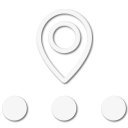At least where I live, satelite imagery is extremely helpful. It can save you a ton of time going down dead ends that lead to nothing. Be aware that sat imagery is a double edged sword, as it can be exceptionally useful in identifying tracks and potential camp sites, but depending on the age of the imagery and the type of biome you're in, it can have significantly changed since the sat photo was taken. I find it very useful to scout with the satelite photos and then check out the area myself, comparing what I actually find on the ground to what the satelite showed. The more you do this, the better you get at "reading" the sat images and knowing when there's a track or other feature.
It will vary depending on where you're looking, but most places have some kind of map or interactive map available that shows public land (called crown land, in Canada). This is very important for many reasons, partly for ensuring you don't go out of bounds into someone's private property without knowing it, and partly to defend yourself in case any Karens show up and try to tell you can't be somewhere - you can be confident/prove that you're on public land.
Also, educate yourself regarding the laws/regulations where you're going. For example, in BC where I grew up, it's actually legal to travel on/do activities on/camp on private land IF it's not fenced or posted with no-trespassing signs. Basically in BC the law says you're allowed to use the unoccupied land even if it's private unless the owner takes reasonable steps (fences and signs) to keep you out. The same is not true in Alberta, one province over.






